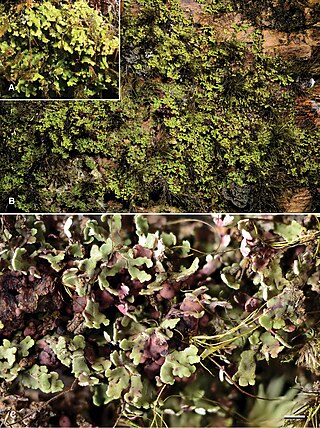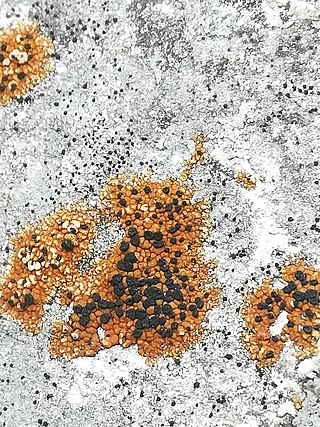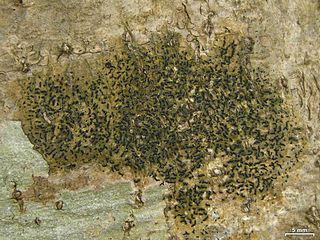Aciculopsora is a genus of lichens in the family Ramalinaceae. It was circumscribed by lichenologists André Aptroot and Marie Trest in 2006.
Coppinsia is a genus of lichenized fungi in the family Trapeliaceae. This is a monotypic genus, containing the single species Coppinsia minutissima.

Krogia is a genus of corticolous lichens in the family Ramalinaceae. It occurs in tropical humid forests and rainforests. The genus was circumscribed by Norwegian lichenologist Einar Timdal in 2002, with Krogia coralloides assigned as the type species.

Toniniopsis is a genus of crustose and squamulose lichens in the family Ramalinaceae. The genus was circumscribed by Swiss lichenologist Eduard Frey in 1926, with Toniniopsis obscura designated the type and only species. The genus name of Toniniopsis is in honour of Carlo Tonini (1803–1877), who was an Italian chemist and botanist (Lichenology), who worked in Verona and was a member and President of the Academy of Agriculture. As a result of molecular phylogenetic studies, several species, formerly classified in genus Bacidia, have been transferred to Toniniopsis.

Toninia is a genus of lichen-forming fungi in the family Ramalinaceae.
Clypeopyrenis is a genus of lichen-forming fungi in the family Pyrenulaceae. The genus was circumscribed in 1991 by Dutch lichenologist André Aptroot, with Clypeopyrenis microsperma assigned as the type species. This lichen, originally described from material collected in Costa Rica, is also found in the Caribbean and South America. Clypeopyrenis porinoides was added to the genus in 2011; it was discovered in Costa Rica, close to the type locality of the type species.
Combea is a genus of lichens in the family Opegraphaceae. It has two species. The genus was circumscribed by Italian botanist Giuseppe De Notaris in 1846.
Clauzadella is a genus of fungi in the family Verrucariaceae. A monotypic genus, it contains the single species Clauzadella gordensis, discovered in France and described as new to science in 1996 by Pere Navarro-Rosinés and Claude Roux.
Zwackhiomyces is a genus of lichenicolous fungi in the family Xanthopyreniaceae. The genus was circumscribed by Martin Grube and Josef Hafellner in 1990, with Zwackhiomyces coepulonus assigned as the type species.
Sagema is a fungal genus in the family Lecanoraceae. It is a monotypic genus, containing a single species, the crustose lichen Sagema potentillae, found in Nepal. Both the genus and species were described in 1993 by lichenologists Josef Poelt and Martin Grube.
Skyttella is a genus of lichenicolous fungi in the family Cordieritidaceae. It contains two species. The genus was circumscribed in 1988 by David Leslie Hawksworth and Rolf Santesson, with Skyttella mulleri assigned as the type species. This species, which parasitizes the lobes of foliose lichens in the genus Peltigera, was previously classified in the genus Phacopsis. Skyttella stictae, an Ecuadorian species that grows on Sticta, was added to the genus in 2017.
Poeltiaria is a genus of lichen-forming fungi in the family Lecideaceae. It was circumscribed in 1984 by lichenologist Hannes Hertel, with Poeltiaria turgescens assigned as the type species.
Gregorella is a genus of lichenized fungi in the family Arctomiaceae. This is a monotypic genus, containing the single species Gregorella humida.

Phoebus is a fungal genus of previously uncertain familial placement in the order Arthoniales, now placed in the family Lecanographaceae thanks to molecular analyses. It contains only one species, Phoebus hydrophobius, found in the Ozarks of the central United States, and described as new to science in 2007.
Vezdaea is a genus of crustose lichens in the monotypic family Vezdaeaceae, which itself is the only taxon in the order Vezdaeales. The genus was circumscribed by Elisabeth Tschermak-Woess and Josef Poelt in 1976. The genus name honours Czech lichenologist Antonín Vězda (1920-2008).

Coenogonium is a genus of filamentous lichens in the monotypic family Coenogoniaceae. It has about 90 species. Most species are leaf-dwelling or grow on bark, although a few are known to grow on rocks under certain conditions, and some are restricted to growth on termite nests. The genus was circumscribed in 1820 by German naturalist Christian Gottfried Ehrenberg.
Eugeniella is a genus of mostly leaf-dwelling (foliicolous) lichens in the family Pilocarpaceae. It contains 13 species. The genus was circumscribed in 2008 by lichenologists Robert Lücking, Emmanuël Sérusiaux, and Klaus Kalb, with Eugeniella psychotriae assigned as the type species. This lichen was originally called Patellaria psychotriae by Johannes Müller Argoviensis in 1881. The seven species that were initially included in the genus had previously been placed in the genera Bacidia and Byssoloma. Several newly identified species from Australasia and Central and South America were later added. Most of the species grow on leaves, although four of the Australasian species grow on bark.

Zwackhia is a genus of crustose lichens in the family Lecanographaceae. It has six species. The genus was circumscribed in 1855 by German lichenologist Gustav Wilhelm Körber. He assigned Zwackhia involuta as the type species; this species is now known as Z. viridis.
Henricus (Harrie) Johannes Maria Sipman is a Dutch lichenologist. He specialises in tropical and subtropical lichens, and has authored or co-authored more than 250 scientific publications. He was the curator of the lichen herbarium at the Berlin Botanical Garden and Botanical Museum from 1983 until his retirement in 2010.

Robert Lücking is a German lichenologist. He earned his master's and PhD from the University of Ulm, focusing on the taxonomy, ecology, and biodiversity of foliicolous lichens. He has received numerous awards for his work, including the Mason E. Hale Award for his doctoral thesis, the Augustin Pyramus de Candolle prize for his monograph, and the Tuckerman Award twice for his publications in The Bryologist. Since 2015, he has been serving as the curator of lichens, fungi, and bryophytes at the Berlin Botanical Garden and Botanical Museum, and several lichen species and a genus have been named in his honour.






